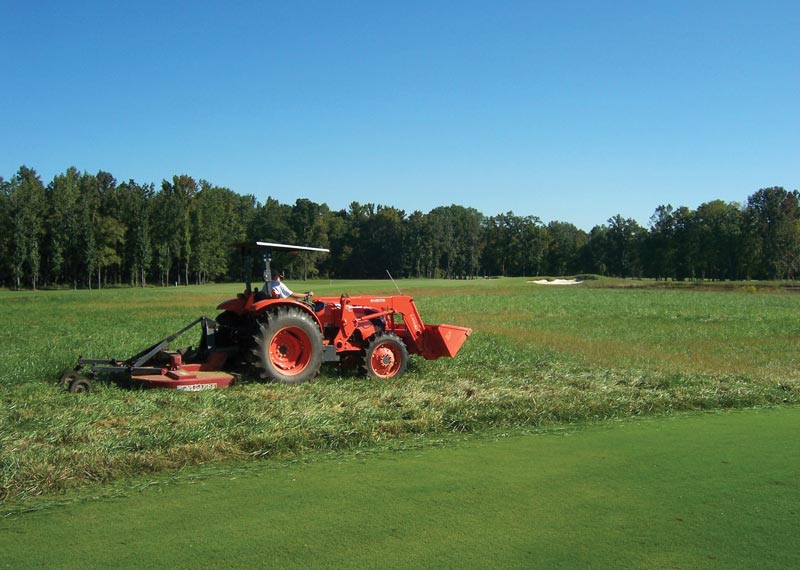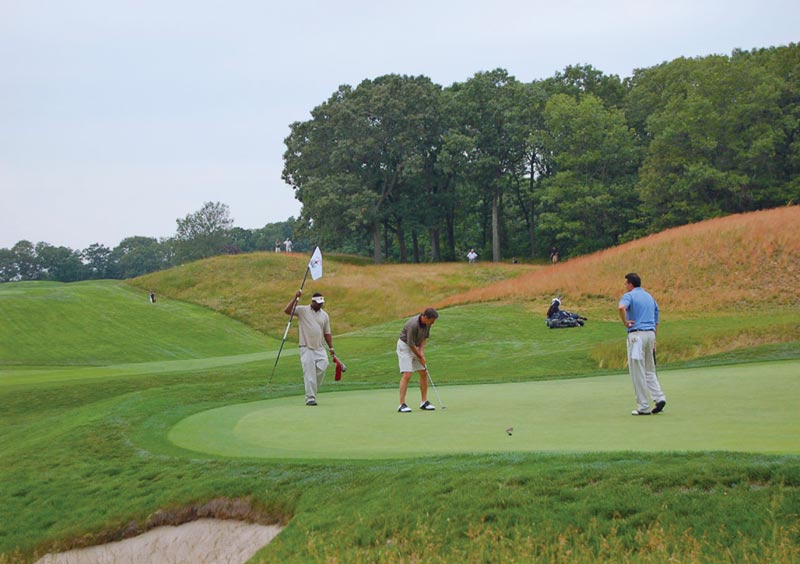
Monostands and mixes such as fescues (pictured is Aurora Gold hard fescue), lovegrass, bluestems, broomsedge, wheatgrass and indiangrass require minimal inputs and can provide a clean contrast to playable turf. Photos courtesy of Kyle Miller
In an industry pressured for cost savings, golf course superintendents must consider every option, and that includes going natural. Called by many names, including “native,” “natural” and “naturalized,” these areas help create a contrast to intensely managed turf and expand a golf course’s supply of wildlife habitat.
While an aesthetic case for naturalized areas is easy to make, many superintendents are converting intensely managed turf to naturalized landscapes to cut their input costs related to fuel, fertilizer, irrigation, pesticides and labor. The deep root systems of these naturalized areas are, for example, more tolerant of environmental stresses and require less irrigation. But don’t confuse going natural properly with letting nature take over.
Left to grow at nature’s will, naturalized areas are bound to turn into large weed patches and overgrown eyesores that can become a no-man’s land of irretrievable golf balls. Unlike turf and groomed landscapes, a naturalized area’s success relies on a low-maintenance but methodical approach that includes both pre-emergence and post-emergence herbicides.
Choosing plants and planning maintenance
The types of indigenous or non-native plants a superintendent chooses for naturalized areas will have a significant impact on maintenance needs.
Monostands or mixes consisting of fescues, lovegrass, bluestems, broomsedge, wheatgrass, indiangrass and others provide a clean contrast to playable turf and require minimal maintenance inputs. Great for sloped areas prone to erosion, some varieties of mixes even offer natural weed defenses.
Native flowers and wildflowers add color to a course’s landscape but do require more care to ensure seasonal blooms and growth succession over invasive, aggressive weeds. When grown from seed, wildflowers may take up to three years to provide the desired impact. Some of the most popular choices for golf courses are cosmos, yarrow, baby’s breath, black-eyed Susan, primrose, poppy and Shasta daisy.
Controlling weeds in a naturalized area inhabited by wildflowers can present challenges for superintendents. Herbicides meant to knock down broadleaf weeds may also kill wildflowers, which are categorized as broadleaf species. As a result, these wildflower areas may require hand weeding and spot spraying to remove unsightly broadleaf weeds. You can control weedy grasses, however, with selective herbicides. If you are planting wildflowers, consider the size of the planting area and understand that these areas will require some hand weeding to deliver their full benefits.
Maintenance timeline for a naturalized area
- Mow in spring and apply a pre-emergence herbicide.
- Monitor the amount of wildlife living in the naturalized area. If animals or insects have become pests to players, decrease the amount of food- and shelter-giving plants in the area.
- Spot-spray and hand-weed as needed if weed pressure increases during summer months.
- Mow in fall and apply a pre-emergence herbicide before dormancy hits.
- If allowed, consider burning to clean out debris and vegetation to promote new growth.
- If desired, label the indigenous grasses and flowers, both to educate golfers and to help remind maintenance crews which plants are intentional.
Getting started going natural
Establishing strong, healthy plants is key for weed management in low-maintenance, naturalized areas. When establishing a new area, use a nonselective chemical treatment to eliminate weeds, and then lightly till. Next, use a low seed rate per acre to avoid thick stands of vegetation. Be sure to time seeding with seasonal rains to minimize the need for irrigation. With these new areas, it’s important to communicate progress to your members, because plants may take years to develop and achieve the desired effect.

Mow naturalized areas twice a year: once in spring for a fresh growing season, and once in fall before plants go into dormancy.
Using established plants, if available, eliminates the need to wait for the area to develop. Plant them in fall to make the most of favorable soil temperatures and decreased weed pressure. You can also cut costs by building an out-of-sight nursery to grow native varieties in until they’re ready for planting. Space mature plants apart so players have room to walk in and play a missed shot back onto a fairway. A number of grass options — including lovegrass, fescues, broomsedge and bluestem — work well in these areas.
Managing weeds in naturalized areas
A golf course’s routine maintenance should include seasonal thinning, trimming, mowing and spraying of naturalized areas to sustain the integrity and playability of the course landscape.
A management plan starts with an inventory of current herbicides in the chemical storage building. Categorize your existing herbicides by application timing, use areas and weeds controlled. Note pre-emergence and post-emergence herbicides, whether use sites are appropriate for wildflower areas and native grass areas, and their control of broadleaf weeds, sedges and grassy weeds. While many herbicides labeled for golf course use don’t list native grasses and wildflowers specifically, language on the label usually allows you to evaluate the herbicide on your particular species. In addition, many product labels include native grasses and wildflowers that are tolerant of a particular herbicide in the ornamental section of the label. Test the product on a small area to determine tolerance before making applications to larger areas.
Make pre-emergence herbicides the pillar of any naturalized area maintenance plan. Most pre-emergence herbicides labeled for golf course use evolved from crop applications, which typically control tall and unsightly weeds commonly found in naturalized areas. These include grassy weeds such as barnyardgrass, foxtail, johnsongrass, panicum and witchgrass, as well as broadleaf weeds such as lamb’s-quarters, pigweed, spurge and smartweed.
Because most pre-emergence herbicides affect only the roots of germinating weed seeds, they’re generally labeled for use on mature grasses with a well-established root system. Using herbicides to preventively control weeds will be the most cost-effective strategy. If you can prevent outbreaks with one product application, you’ll save the time and expense of applying multiple products on multiple weed varieties.

Space mature plants apart in naturalized areas to give golfers room to walk in and play a missed shot back onto the fairway. For these areas, lovegrass, fescues, broomsedge and bluestem work particularly well.
Apply herbicides annually as part of routine maintenance. Other strategies such as mowing and thinning the vegetation will promote healthy growth and keep the area playable.
Also consider mowing naturalized areas twice a year: once in spring to provide for a clean, fresh growing season, and then again in fall before plants go into dormancy. Spring and fall are ideal times to apply a pre-emergence herbicide to control weeds.
After a naturalized area has been established for a few years, consider getting a permit for a controlled burn of the area. An annual burn during the early spring months will encourage hearty growth and renew soil.
Once new growth appears, apply a pre-emergence herbicide before grassy and broadleaf weeds invade the area. Post-emergence broadleaf herbicides are effective on naturalized grass areas, but eliminating unsightly grassy weeds can be more challenging. You can choose between several available post-emergence grass herbicides, so study product labels closely to determine whether your stand is tolerant to the herbicide.
Naturalized areas on golf courses continue to develop as a trend. And while they’re not maintenance-free, naturalized areas reduce the amount of management required on the course and boost aesthetics. Properly managed naturalized areas are mutually beneficial to superintendent budgets and player expectations. And when created and managed methodically, naturalized areas offer a visually appealing variation from manicured playing areas.
Kyle Miller is the senior technical specialist for BASF Turf & Ornamentals.